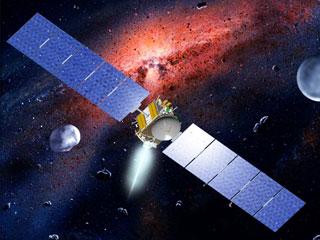
Artist's concept of NASA's Dawn spacecraft, which is closing in on the huge asteroid Vesta. Photo: NASA/JPL.
WASHINGTON (BNS): NASA's Dawn spacecraft has reached a new phase of its mission to Vesta, the second-largest asteroid in the solar system, which is also named as protoplanet by many astronomers.
For the first time the spacecraft will use cameras to aid its approach to Vesta.
According to the mission plan, the ion-propelled probe will enter the orbit around Vesta on July 16 to begin a year-long study of the mysterious space rock.
"We feel a little like Columbus approaching the shores of the New World. The Dawn team can't wait to start mapping this terra incognita,” Space.com quoted Christopher Russell, Dawn principal investigator at UCLA, in a statement.
Vesta is the second-biggest object in the main asteroid belt between Mars and Jupiter with a width of 329 miles (530 kilometers). It appears to have layers – a core, mantle and crust – just as planets such as Earth, Venus and Mars do.
But Vesta isn't large enough to be classed as a "dwarf planet" like the other behemoth of the asteroid belt Ceres – hence the "protoplanet" designation.
Currently, Dawn is about 752,000 miles (1.21 million km) from Vesta, or about three times the distance from the Earth to the moon, researchers said.
Until now, Dawn has been navigating by measuring radio signals between itself and Earth, and using several other methods that didn't involve Vesta. But as Dawn closes in on Vesta during its approach phase, the spacecraft will use cameras to analyze where Vesta appears relative to the stars.
This method should allow mission scientists to pin down and refine Dawn's trajectory very precisely, researchers said.
 Next Article
Next Article













The Indian Air Force, in its flight trials evaluation report submitted before the Defence Ministry l..
view articleAn insight into the Medium Multi-Role Combat Aircraft competition...
view articleSky enthusiasts can now spot the International Space Station (ISS) commanded by Indian-American astr..
view article